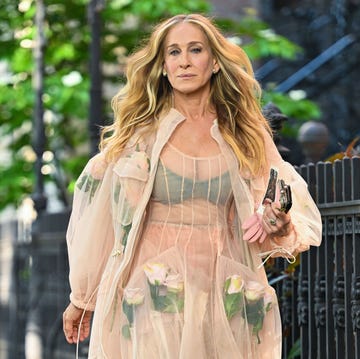Dealing with dull, weak, or thin strands? Take a look at what you're putting on your plate. There’s a strong link between your overall nutrition and the state of your strands.
"One of the first ways I can tell how healthy someone is—and if they’re eating nutritiously—is by looking at their hair," says Whitney Bowe, MD, a board-certified dermatologist based in New York City. Dull, thinning, or breakage-prone stands can be dead giveaways that you aren't getting all the nutrients you need.
Load up on the following 7 foods to make sure you're getting the key nutrients your hair's craving.
MORE: Your Expensive Moisturizer Could Be Seriously Damaging Your Skin (Prevention Premium)
If your hair is dull...
Eat: Salmon
When you’re low on healthy fats, your hair starts to lose its natural shine. Salmon is full of omega-3 fatty acids that feed the oil gland around hair follicles, helping lubricate hair for added luster, says Bowe. Aim for two 3.5-ounce portions per week (the amount recommended by the American Heart Association). Not a fish fan? Flaxseeds are also an excellent source of fatty acids.
MORE: 2 Super-Easy Salmon Recipes
If your scalp is flaky...
Eat: Pumpkin seeds
One ounce of whole, roasted pumpkin seeds (about a ½ cup) supplies 19% of your daily requirement of zinc, a mineral which may help prevent scalp dryness, says Rebecca Kazin, MD, assistant professor of dermatology at Johns Hopkins University. Incorporate other zinc-rich foods like fortified cereals, pork, yogurt, and cashews, to help you reach the 8 mg you need each day.
MORE: The 100 Best Supplements For Women
If your hair is thinning...
Eat: Chicken
You may not be able to stop normal, everyday hair loss (we lose an average of 50 to 100 strands per day), but you can help build the count back up by taking in enough protein, the building blocks for hair. “Without enough protein, your body can’t replace the hairs that you naturally shed every day,” says Kazin. Try chicken: A 4-ounce serving packs 35 grams, more than 75% of a woman’s daily recommended intake (these 20 not-boring chicken recipes will do the trick). Vegetarians can reach for quinoa (8 grams of protein per cooked cup), chickpeas (15 grams of protein per cooked cup), or lentils (18 grams of protein per cooked cup) instead.
MORE: 6 Delicious Ideas For Quinoa
If your hair keeps breaking...
Eat: Strawberries
Your body needs vitamin C to help create protein, and your body’s ability to make enough of that hair-and muscle-builder is key for strong, unbreakable strands, says Bowe. Strawberries are chock full of vitamin C, with one cup packing 113% of your recommended daily allowance (vitamin C is fine to get in excess, as you’ll pee out what you don’t need). You can also reach for other top C sources like peppers, guavas, and citrus fruits.
MORE: 20 Scrumptious Strawberry Recipes
If your scalp burns easily...
Eat: Almonds
A great on-the-go snack, almonds are also an excellent source of vitamin E, an antioxidant that can absorb energy from UV light—protecting skin cells in the process. It can even help repair the damage from previous sun exposure on your scalp, says Kazin. Just one ounce offers half of your daily recommended intake of 15 mg. An ounce of dry-roasted sunflower seeds packs about the same amount.
MORE: 3 Nutrient-Packed Seeds To Eat Every Day
If you're suffering from serious hair loss...
Eat: Beans
There’s a difference between slightly thinning strands and noticeable, I-can-see-my-scalp hair loss, and the latter can be caused by iron deficiency. “It’s easy for women to run low on iron because of their monthly cycle,” says Bowe, who tests her patients for iron deficiency at the first sign of significant hair thinning. Have your doctor check your iron levels and ask how much of the mineral she recommends (in general, women younger than 50 should aim for 18 mg of iron per day, while those 50+ need just 8 mg). Clams and oysters are among the highest food sources of the mineral, but beans are probably a more realistic everyday option. One cup of white beans packs nearly 8 mg of iron.
Note: If your iron levels are normal but your hair loss won't stop, talk to your dermatologist. The problem could be caused by a more serious issue like female-pattern baldness or thyroid dysfunction.
If your natural color is fading...
Eat: Shiitake Mushrooms
These small wonders are a top source of copper, which may help hair maintain its natural color, says Kazin. In fact, a 2012 study found that low copper intake could be linked to premature graying. There’s no standard RDA for copper, but the Mayo Clinic recommends a minimum of 1.5 mg per day. Half a cup of cooked shiitake mushrooms provides nearly half that amount (savor them in this easy wild mushroom burger). Seaweed and sesame seeds are also good sources.
MORE: 12 Highly Effective Solutions For Thinning Hair















